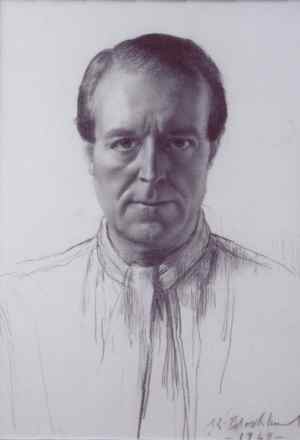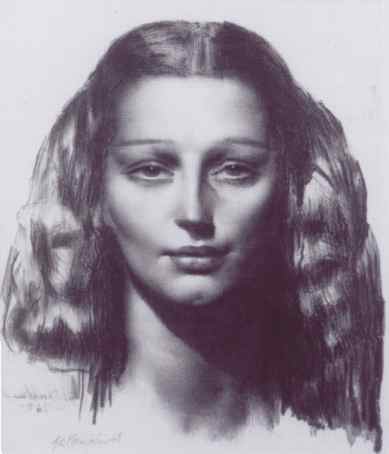Editor's note: The Muscatine Art Center provided
source material to Resource Library for the following article or
essay. If you have questions or comments regarding the source material,
please contact the Muscatine Art Center directly through either this phone
number or web address:
Gerald L. Brockhurst (1890-1978),
A Retrospective from the William P. Brumfield Memorial Collection
January 9 - February 27, 2005
British-American artist
Gerald Leslie Brockhurst (1890-1978) is regarded as one of the 20th century's
finest portrait artists. However, the  fame
of a painter can be as fleeting as that of any other celebrity. This
has been true of the work of Gerald Leslie Brockhurst. In the 1930's
and 1940's Brockhurst was probably the most celebrated portraitist, first
in England, then in America. He specialized in portraying beautiful
women, often-famous personalities such as Marlene Dietrich and the Duchess
of Windsor.(right: Gerald Leslie Brockhurst, Self Portrait, 1949,
black chalk on paper)
fame
of a painter can be as fleeting as that of any other celebrity. This
has been true of the work of Gerald Leslie Brockhurst. In the 1930's
and 1940's Brockhurst was probably the most celebrated portraitist, first
in England, then in America. He specialized in portraying beautiful
women, often-famous personalities such as Marlene Dietrich and the Duchess
of Windsor.(right: Gerald Leslie Brockhurst, Self Portrait, 1949,
black chalk on paper)
Probably no artist suffers a quicker decline in popularity
than a fashionable portraitist. Posthumously there is little interest
among collectors or museums in the work and most of the portraits remain
with families of the sitters, disappearing from public view. Such
has been the case with Brockhurst paintings.
Fortunately, Brockhurst's critical reputation has been
sustained during the post thirty-plus years by interest in his technically
brilliant etchings, which have always been admired by print collectors and
connoisseurs. Although Brockhurst began working in etching in 1904,
it was not until 1920 that he produced his first editioned print, a portrait
of the Irish poet, Francis Mac Namara. He executed eighteen additional
etchings that year, however, some were not printed in editions.
Printmaking had become a serious aspect of his art career.
In 1921 he was elected to membership in the Royal Society of Painter-Etchers
and Engravers. However, as his etching technique became more meticulous
and time consuming, he produced fewer and fewer plates each year.
Brockhurst's most famous etching, Adolescence, was published in 1932.
It it Brockhurst overcame all difficulties of depicting on a metal plate
the reflection of a nude figure in a mirror and produced his largest and
most ambitious etching. This extraordinary plate is regarded by many
art scholars as one of the masterpieces of etching of this century.
In 1939, Brockhurst and his model for Adolescence, Dorette, left England
and settled in the United States. Despite his fame abroad the American
art establishment seems to have ignored the artist. However the commissioned
portraits continued in America. During his lifetime he painted over
six hundred portraits.
Brockhurst normally worked slowly and painstakingly, whether
at painting or printmaking. This required considerable patience of
his sitters. Brockhurst's most famous plates go far beyond ordinary
line etchings. He achieved a stipple effect to give the appearance
of background and flesh tones that is unsurpassed in its refinement and
brilliant craftsmanship. It has been said that many people first think
Brockhurst's prints are aquatints, however, they are etchings done dot by
dot, line by line.
The exhibition comes from the collection of the late William
P. Brumfield of Baton Rouge, Louisiana and has been organized by the  Louisiana Arts and Science Center. The collection
includes all but two of the prints Brockhurst executed during his lifetime.
(right: Gerald Leslie Brockhurst, Head of a Girl (also called
Dorette and The Head of a Young Girl), 1942, lithograph)
Louisiana Arts and Science Center. The collection
includes all but two of the prints Brockhurst executed during his lifetime.
(right: Gerald Leslie Brockhurst, Head of a Girl (also called
Dorette and The Head of a Young Girl), 1942, lithograph)
Text from the gallery guide for the exhibition
Shortly after his graduation from the Tulane University
Law School in the early 1970s, young William P. "Billy" Brumfield
wandered into my art gallery in New Orleans. There his keen eye led him
to purchase his first print by Gerald L. Brockhurst, Jeunesse Dorée,
regarded as one of the artist's finest etchings. Today the collection formed
by Billy Brumfield, and devoutly continued by his sister Julia Brumfield
Sims following his untimely death, contains all the finest prints by Brockhurst.
The William P. Brumfield Memorial Collection is probably
the most comprehensive collection of prints by Gerald Brockhurst in the
world, surpassing most, if not all, museum collections. It includes not
only all of the rare thirteen states of the masterful etching Henry Rushbury
#2, a portrait of Brockhurst's longtime friend and colleague, but also
the only known self-portrait of Brockhurst, a drawing done in 1949. Rounding
out the collection are an oil painting, several other drawings, and Brockhurst's
only woodcut.
Gerald Leslie Brockhurst was born in Birmingham, England,
in 1890, the youngest of four sons. An independent-minded boy, he attended
a variety of schools, where he did not fare well scholastically. He had
difficulty writing, so he began to draw, and before long his teachers were
thinking of him as "a young Botticelli."
Brockhurst entered the Birmingham School of Art when he
was only twelve. The school was noted for its belief in precise draftsmanship
-- a belief derived from the influence of the Pre-Raphaelites. The faculty
recognized Brockhurst's exceptional drawing ability and gave him special
attention. At seventeen, he entered the prestigious Royal Academy School
in London, and there he won prizes for his paintings and drawings, including
the Royal Academy Gold Medal for General Excellence and a traveling scholarship.
The scholarship enabled Brockhurst to travel in Italy and
France, where he studied firsthand the works of the old masters, especially
Piero della Francesca, Sandro Botticelli, and Leonardo da Vinci. He later
moved to Ireland with his wife, Anaïs, an artist whom he had met in
his student days. After living in Ireland for several years, he and Anaïs
returned to London, where his first major exhibition of paintings won Brockhurst
immediate recognition as an artist. He was twenty-nine.
Brockhurst, who was almost entirely self-taught as an etcher,
had begun to explore etching as early as 1914. In 1920, he produced his
first editioned print, an etching of the Irish poet Francis MacNamara, and
etched an additional eighteen plates of other subjects. In 1921, Brockhurst
was elected to membership in the Royal Society of Painter-Etchers and Engravers.
Printmaking became an important aspect of Brockhurst's
career with his wife as his primary model. But because his etching technique
became more meticulous and time-consuming, he produced fewer plates each
year. The renowned printmaker Stanley W. Hayter, looking at a group of Brockhurst
etchings years later in my gallery, told me that although many people might
mistake them for aquatints, they were indeed "etchings done dot by
dot, line by line."
In the early 1930s, a teenager named Kathleen "Dorette"
Woodward replaced Anaïs as the artist's favorite model and, eventually,
intimate companion.The haunting etching Dorette was the first published
print of her. She was also the model for Brockhurst's most famous plate,
Adolescence, published in 1932. It is one of the acknowledged masterpieces
of twentieth-century etching and one of the few nudes in Brockhurst's oeuvre.
It is a large, complex plate and an unusually sensual image. Like all of
Brockhurst's best etchings, Adolescence shows his use of stippling
to produce an appearance of background and flesh tones that is unsurpassed
in its craftsmanship and refinement.
Following the publication of Adolescence, a London
newspaper reported on the relationship between Dorette and Brockhurst, who
was then earning the highest income of any British portrait painter of the
period. The story created a scandal in England, and Anaïs sued for
divorce. By the time the divorce was final, several years later, Brockhurst
had settled in America, where he and Dorette married in 1947. He became
a U.S. citizen in 1949.
Despite Brockhurst's fame abroad, the American art establishment
paid little attention to him. He continued his lucrative career painting
commissioned portraits, including many of celebrities, socialites, and corporate
executives; but he produced only five etchings and some lithographs after
leaving England. His work was seldom exhibited in America and little was
written about him. Knowledgeable print collectors here and in England, however,
continued to collect his prints.
Brockhurst died in New Jersey in 1978 at the age of eighty-eight.
In recent years, museums in England and America have begun to reexamine
his work. The William P. Brumfield
Memorial Collection will aid their reevaluation and help to assure Gerald
L. Brockhurst's reputation as one of the best portrait etchers in art history.
-- Abe M. Tahir Jr. Art Consultant
Editor's note: RL readers may also enjoy:
Read more articles and essays concerning this source by
visiting the sub-index page for the Muscatine
Art Center in Resource Library
Visit the Table
of Contents for Resource Library for thousands
of articles and essays on American art, calendars, and much more.
Copyright 2005 Traditional Fine Arts Organization, Inc., an Arizona nonprofit corporation. All rights
reserved.
 fame
of a painter can be as fleeting as that of any other celebrity. This
has been true of the work of Gerald Leslie Brockhurst. In the 1930's
and 1940's Brockhurst was probably the most celebrated portraitist, first
in England, then in America. He specialized in portraying beautiful
women, often-famous personalities such as Marlene Dietrich and the Duchess
of Windsor.(right: Gerald Leslie Brockhurst, Self Portrait, 1949,
black chalk on paper)
fame
of a painter can be as fleeting as that of any other celebrity. This
has been true of the work of Gerald Leslie Brockhurst. In the 1930's
and 1940's Brockhurst was probably the most celebrated portraitist, first
in England, then in America. He specialized in portraying beautiful
women, often-famous personalities such as Marlene Dietrich and the Duchess
of Windsor.(right: Gerald Leslie Brockhurst, Self Portrait, 1949,
black chalk on paper) Louisiana Arts and Science Center. The collection
includes all but two of the prints Brockhurst executed during his lifetime.
(right: Gerald Leslie Brockhurst, Head of a Girl (also called
Dorette and The Head of a Young Girl), 1942, lithograph)
Louisiana Arts and Science Center. The collection
includes all but two of the prints Brockhurst executed during his lifetime.
(right: Gerald Leslie Brockhurst, Head of a Girl (also called
Dorette and The Head of a Young Girl), 1942, lithograph)